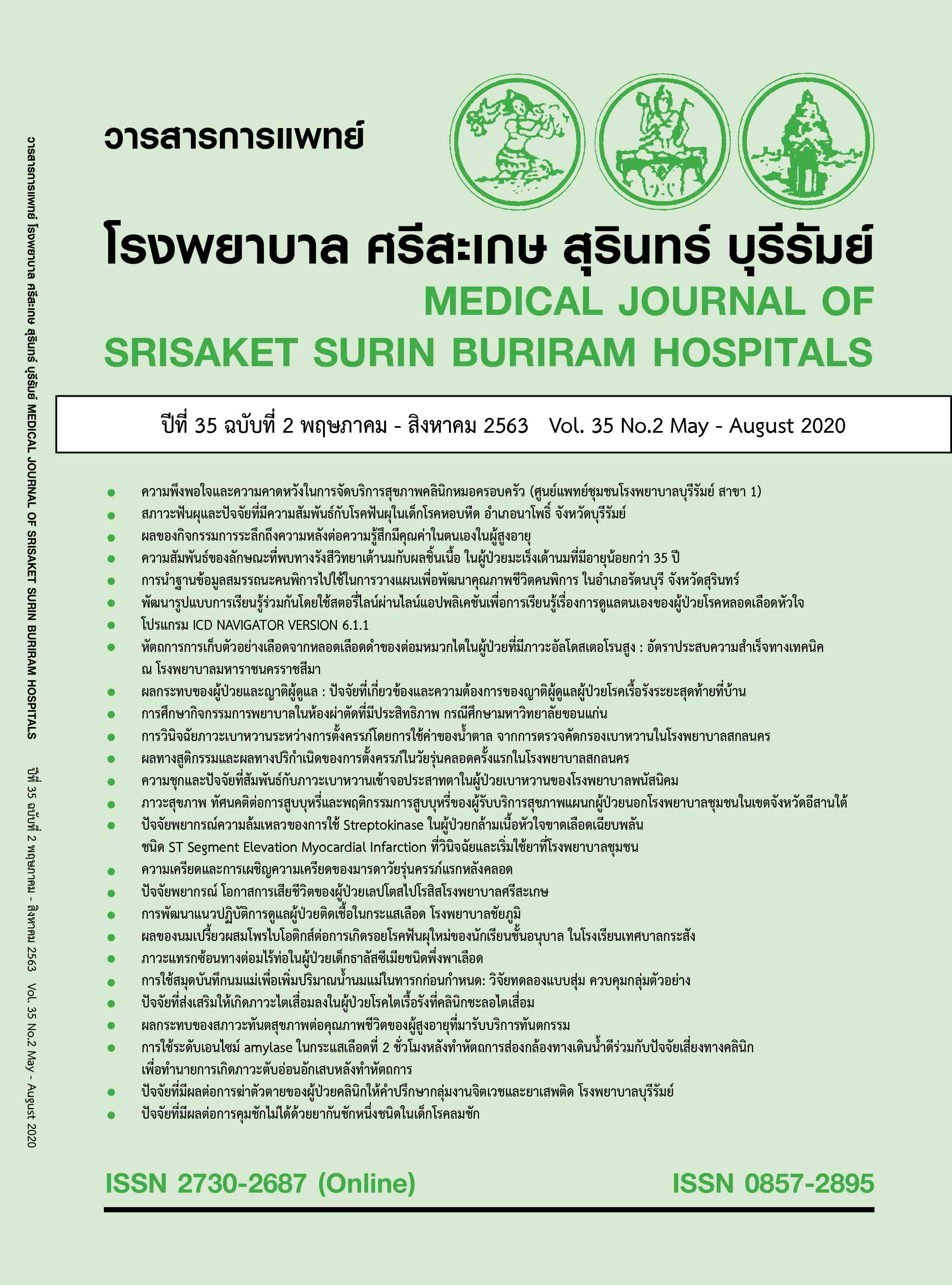การใช้ระดับเอนไซม์ amylase ในกระแสเลือดที่ 2 ชั่วโมงหลังทำหัตถการส่องกล้องทางเดินน้ำดีร่วมกับปัจจัยเสี่ยงทางคลินิกเพื่อทำนายการเกิดภาวะตับอ่อนอักเสบหลังทำหัตถการ
Main Article Content
บทคัดย่อ
หลักการและเหตุผล: ตับอ่อนอักเสบเป็นภาวะแทรกซ้อนที่พบบ่อยของการทำหัตถการส่องกล้องทางเดินน้ำดีและมีความรุนแรงถึงแก่ชีวิต การวินิจฉัยภาวะนี้โดยอาศัยลักษณะทางคลินิกขาดความน่าเชื่อถือและล่าช้า จึงมีการใช้ระดับเอนไซม์ amylase ในกระแสเลือดเพื่อช่วยทำนายภาวะตับอ่อนอักเสบหลังทำหัตถการ
วัตถุประสงค์: เพื่อประเมินการใช้ระดับเอนไซม์ amylase ในกระแสเลือดที่ 2 ชั่วโมงหลังทำหัตถการส่องกล้องทางเดินน้ำดีร่วมกับปัจจัยเสี่ยงทางคลินิกมาทำนายการเกิดภาวะตับอ่อนอักเสบหลังทำหัตถการ
วิธีการศึกษา: การศึกษาแบบเก็บข้อมูลไปข้างหน้าในผู้ป่วยที่ได้รับการส่องกล้องทางเดินน้ำดีระหว่าง เดือนกุมภาพันธ์ พ.ศ.2560 ถึงเดือนธันวาคม พ.ศ.2562 ในโรงพยาบาลสุรินทร์ ภายหลังทำหัตถการ 2 ชั่วโมง ผู้ป่วยจะได้รับการเจาะเลือดตรวจระดับเอนไซม์ amylase ข้อมูลปัจจัยเสี่ยงทางคลินิก หัตถการและระดับเอนไซม์ amylase ถูกนำมาวิเคราะห์เพื่อทำนายภาวะตับอ่อนอักเสบ
สถิติที่ใช้: ข้อมูลทั่วไปแจงนับใช้สถิติวิเคราะห์ Fisher’s exact test ส่วนข้อมูลต่อเนื่องใช้ t-test เปรียบเทียบ 2 กลุ่ม การหาจุดตัดระดับเอนไซม์ amylase ที่ 2 ชั่วโมงใช้การวิเคราะห์พื้นที่ใต้กราฟ ROC การคำนวณแต้มต่อของปัจจัยเสี่ยงใช้การวิเคราะห์ถดถอยพหุ logistic
ผลการศึกษา: จำนวนหัตถการส่องกล้องทางเดินน้ำดีทั้งหมด 355 ครั้ง ภาวะตับอ่อนอักเสบหลังทำหัตถการเกิดในผู้ป่วย 41 ราย คิดเป็นร้อยละ 11.5 ผู้ป่วยที่เกิดภาวะตับอ่อนอักเสบมีระดับเอนไซม์ amylase ที่ 2 ชั่วโมงสูงกว่าผู้ป่วยที่ไม่เกิดภาวะนี้ (421 vs 104 IU/L, p < 0.001) ค่าจุดตัดของระดับเอนไซม์ amylase ในการทำนายภาวะตับอ่อนอักเสบ คือ 124 IU/L หรือ 1.5 เท่าของค่าปกติสูงสุด มีความไวร้อยละ 85.4 ค่าพื้นที่ใต้กราฟ ROC ร้อยละ 81.7 ปัจจัยเสี่ยงต่อการเกิดตับอ่อนอักเสบจากการวิเคราะห์ตัวแปรเดียวที่มีนัยสำคัญ คือ การใส่ลวดนำเข้าท่อน้ำดียาก (OR 3.02), การใส่ลวดนำเข้าท่อตับอ่อน (OR 3.5), การตัดเปิดหูรูดก่อนใส่ลวดนำ (OR 3.67) และระดับเอนไซม์ amylase ที่ 2 ชั่วโมงมากกว่า 124 IU/L (OR 20.71) เมื่อคุมตัวแปรอื่นจากการวิเคราะห์หลายตัวแปรพบว่า ระดับเอนไซม์ amylase ที่ 2 ชั่วโมงมากกว่า 124 IU/L เป็นปัจจัยในการทำนายภาวะตับอ่อนอักเสบหลังทำหัตถการ (OR 14.78, 95% CI 5.66 – 38.59, p< 0.0001 ) เมื่อใช้ร่วมกับปัจจัยเสี่ยงทางคลินิก คำนวณพื้นที่ใต้กราฟ ROC เพิ่มขึ้นจากการใช้ปัจจัยเสี่ยงทางคลินิกอย่างเดียวอย่างมีนัยสำคัญทางสถิติ (AUC 84.9% VS 68.2%, p < 0.0001)
สรุป: ระดับเอนไซม์ amylase ในกระแสเลือดที่ 2 ชั่วโมงหลังทำหัตถการส่องกล้องทางเดินน้ำดีร่วมกับปัจจัยเสี่ยงทางคลินิกมีความน่าเชื่อถือในทำนายการเกิดตับอ่อนอักเสบหลังทำหัตถการ
คำสำคัญ: ระดับเอนไซม์ amylase, ภาวะตับอ่อนอักเสบหลังทำหัตถการส่องกล้องทางเดินน้ำดี, การทำนาย
Article Details
เอกสารอ้างอิง
Cohen S, Bacon BR, Berlin JA et al. National Institutes of Health State-of-the-science conference statement: ERCP for diagnosis and therapy, January 14-16, 2002. Gastrointest Endosc 2002;56(6):803-9.
Andriulli A, Loperfido S, Napolitano G et al. Incidence rates of post-ERCP complications: A systematic survey of prospective studies. Am J Gastroenterol 2007;102:1781-8.
Kochar B, Akshintala VS, Afghani E et al. Incidence, severity, and mortality of post-ERCP pancreatitis: a systematic review by using randomized controlled trials. Gastrointest Endosc 2015; 81:143-9.
Chandrasekhara V, Khashab MA, Muthusamy VR et al. Adverse events associated with ERCP. Gastrointest Endosc 2017;85:32-47.
Dumonceau JM, Andriulli A, Elmunzer BJ et al. Prophylaxis of post-ERCP pancreatitis: European Society of Gastrointestinal Endoscopy (ESGE) guideline – updated June 2014. Endoscopy 2014;46:799-815.
Cotton PB, Lehman G, Vennes J et al. Endoscopic sphincterotomy complications and their management: an attempt at consensus. Gastrointest Endosc 1991;37:383-93.
Freeman ML, DiSario JA, Nelson DB et al. Risk factors for post-ERCP pancreatitis: a prospective multicenter study. Gastrointest Endosc 2001; 54:425-34.
Masci E, Mariani A, Curioni S, Testoni PA. Risk factors for pancreatitis following endoscopic retrograde cholangiopancreatography: A meta-analysis. Endoscopy 2003;35:830-4.
Cotton PB, Garrow DA, Gallagher J, Romagnuolo J. Risk factors for complications after ERCP: a multivariate analysis of 11,497 procedures over 12 years. Gastrointest Endosc 2009;70:80-8.
Testoni PA, Bagnolo F, Caporuscio, Lella F. Serum amylase measured four hours after endoscopic sphincterotomy is a reliable predictor of postprocedure pancreatitis. Am J Gastroenterol 1999;94:1235-41.
LaFerla G, Gordon S, Archibald M, Murray WR. Hyperamylasemia and acute pancreatitis following endoscopic retrograde cholangiopancreatography. Pancreas 1986;1:160-3.
Gottlieb k, Sherman S, Pezzi J, Esber E, Lehman GA. Early recognition of post-ERCP pancreatitis by clinical assessment and serum pancreatic enzymes. Am J Gastroenterol 1996;91:1553-7.
Testoni PA. Caporuscio S, Bagnolo F, Lella F.Twenty-Four-Hour serum amylase predicting pancreatic reaction after endoscopic sphincterotomy. Endoscopy 1999;31:131-6.
Testoni PA, Bagnolo F. Pain at 24 hours associated with amylase levels greater than 5 times the upper normal limit as the most reliable indicator of post-ERCP pancreatitis. Gastrointest Endosc 2001;53:33-9.
Thomas PR, Sengupta S. Prediction of pancreatitis following endoscopic retrograde cholangiopancreatography by the 4-h post procedural amylase level. J Gastroenterol Hepatol 2001;16:923-6.
Christoforidis E, Goulimaris I, Kanellos I et al. Post-ERCP pancreatitis and hyperamylasemia: Patient-related and operative risk factors. Endoscopy 2002;34:286-92.
Ito K, Fujita N, Noda Y et al. Relationship between post-ERCP pancreatitis and change of serum amylase level after the procedure. World J Gastroenterol 2007;13:3855-60.
Hayashi S, Nishida T, Shimakoshi H et al. Combination of two-hour post-endoscopic retrograde cholangiopancreatography amylase levels and cannulation times is useful for predicting post-endoscopic retrograde cholangiopancreatography pancreatitis. World J Gastrointest Endosc 2016;8:777-84.
Lee YK, Yang MJ, Kim SS et al. Prediction of post-endoscopic retrograde cholangiopancreatography using 4-hour of post-endoscopic retrograde cholangiopancreatography serum amylase and lipase levels. J Korean Med Sci 2017;32(11):1814-1819
Jeurnink SM, Siersema PD, Steyerberg EW et al. Predictors of complications after endoscopic retrograde cholangiopancreatography: a prognostic model for early discharge. Surg Endosc 2011;25:2892-900.


